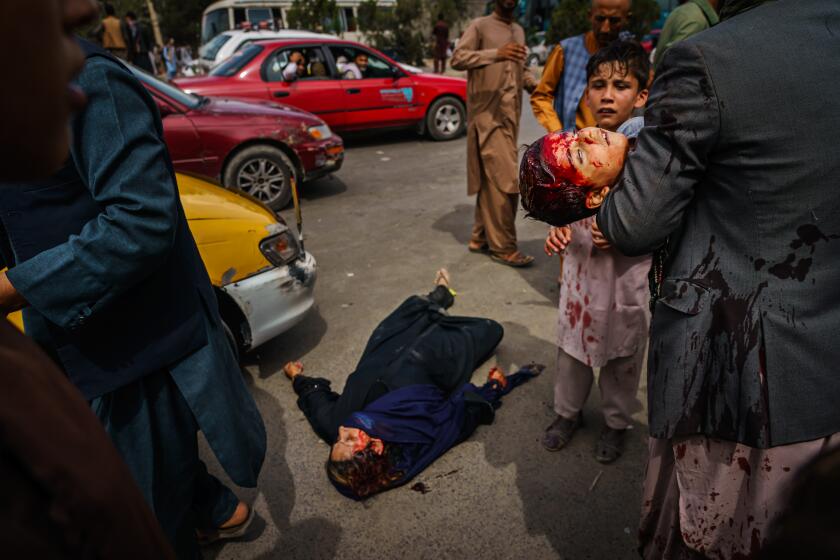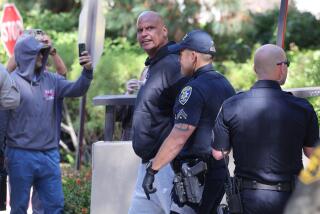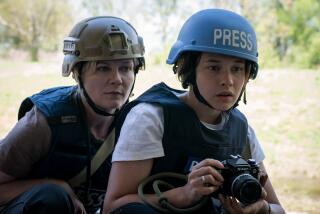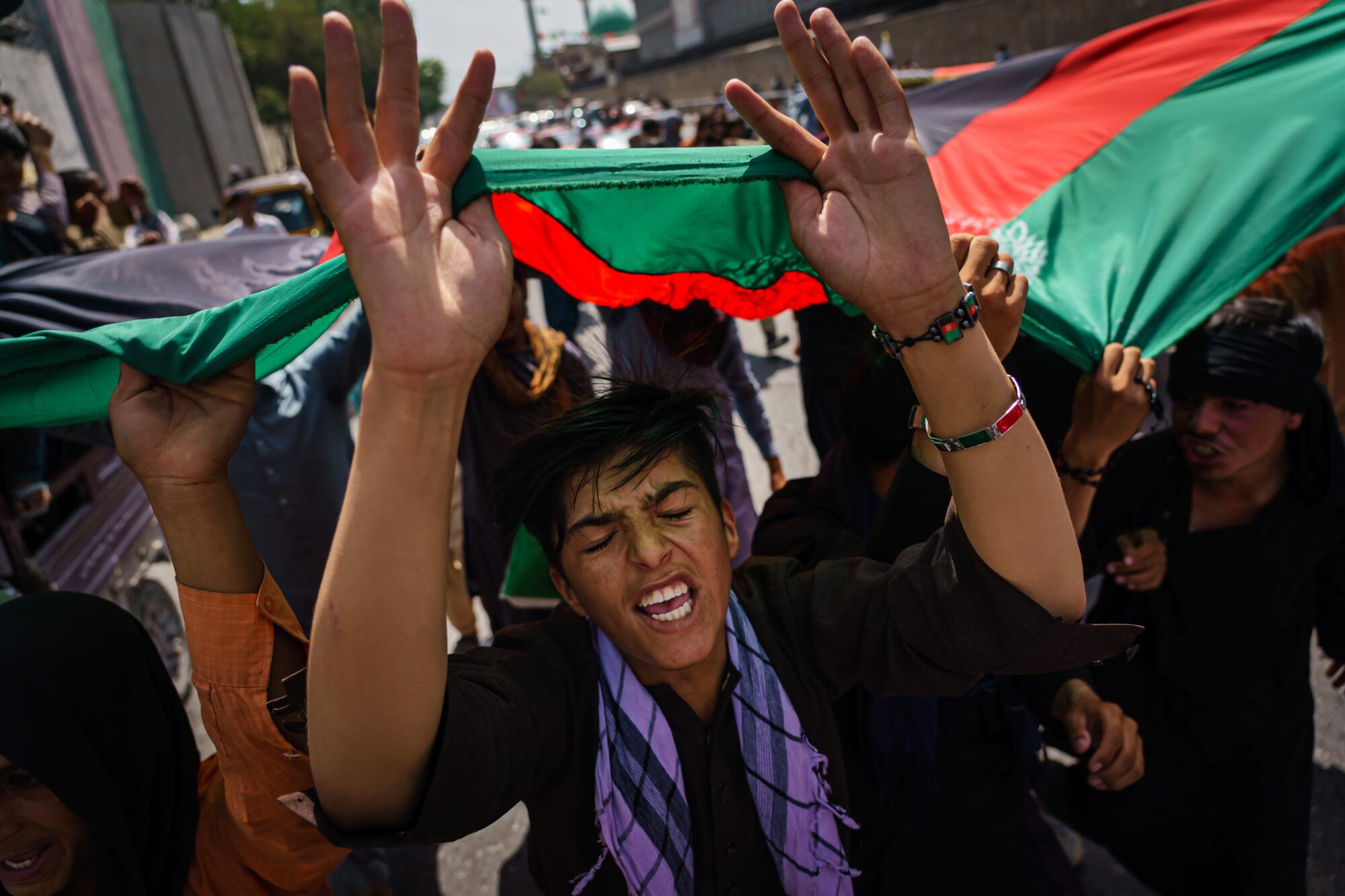
- Share via
KABUL, Afghanistan — When I headed out to work, it had been five days since the Taliban took over Kabul. And it was Independence Day, a national holiday, when Afghans celebrate their country’s independence from Britain in 1919. I wanted to capture the mood of the city.
I went first to an event for Ashura, a religious ritual at which devout Shiite Muslims beat themselves with chains to display penance and mourning. I didn’t spend more time there than necessary, because Shiite Muslim events have often been a target of deadly attacks in Afghanistan. By the time I left, I had drops of blood spattered on my shalwar kameez, the traditional baggy tunic and trousers, as well as my camera, hands, glasses and face.
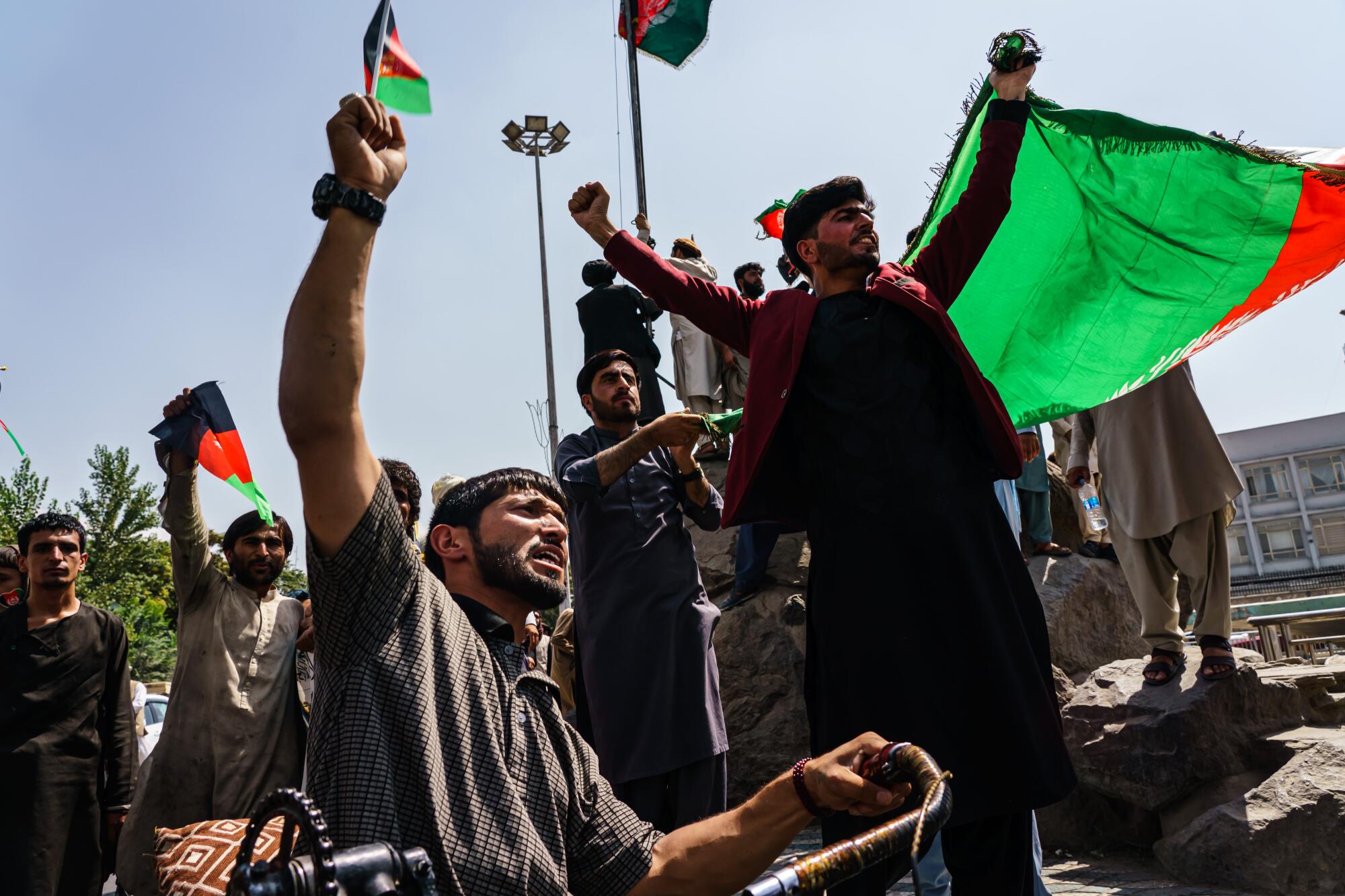
As I stepped outside, I saw a procession of about 200 men, some on motorcycles or bicycles, some walking, carrying Afghan flags. They chanted, “God bless Afghanistan!” I realized these were supporters of the former government, wanting to wave their flag as a symbol of resistance. (The Taliban has raised its own white banner across the city and country.)
So I followed them. I knew they would converge with Taliban fighters.
The protesters climbed on top of a rock foundation in the middle of a traffic circle where there was a flagpole, trying to raise the red, green and black Afghan flag. I climbed up too, hoping to get a view of the crowd and saw Taliban fighters start to move toward us from their guard positions in front of surrounding government buildings. Sport utility vehicles pulled up and fighters jumped off. I realized this was the kind of confrontation that could get ugly fast.

Guns in hand, the Taliban circled the protesters. A fellow journalist and I got ourselves out of the scrum, out of the line of fire. Things escalated. People started pushing and arguing. We crossed the street, weaving between vehicles, to a point where we could make a quick exit or find cover behind cars.
At some point I moved to take a picture of a scuffle. Someone tugged on my camera strap, and I felt the kinetic-energy connection of a fist to the side of my head. A Taliban fighter had sucker-punched me. He was a tall burly man who started screaming in Dari, the local language, pointing at our cameras.
He was joined by another Taliban fighter, shorter and holding a radio in his hand. That fighter attacked my journalist companion, hitting him squarely in the ear. The bigger guy continued to hit me in the head. We tried to speak, to explain that we were foreign journalists, but they pummeled us to the ground.
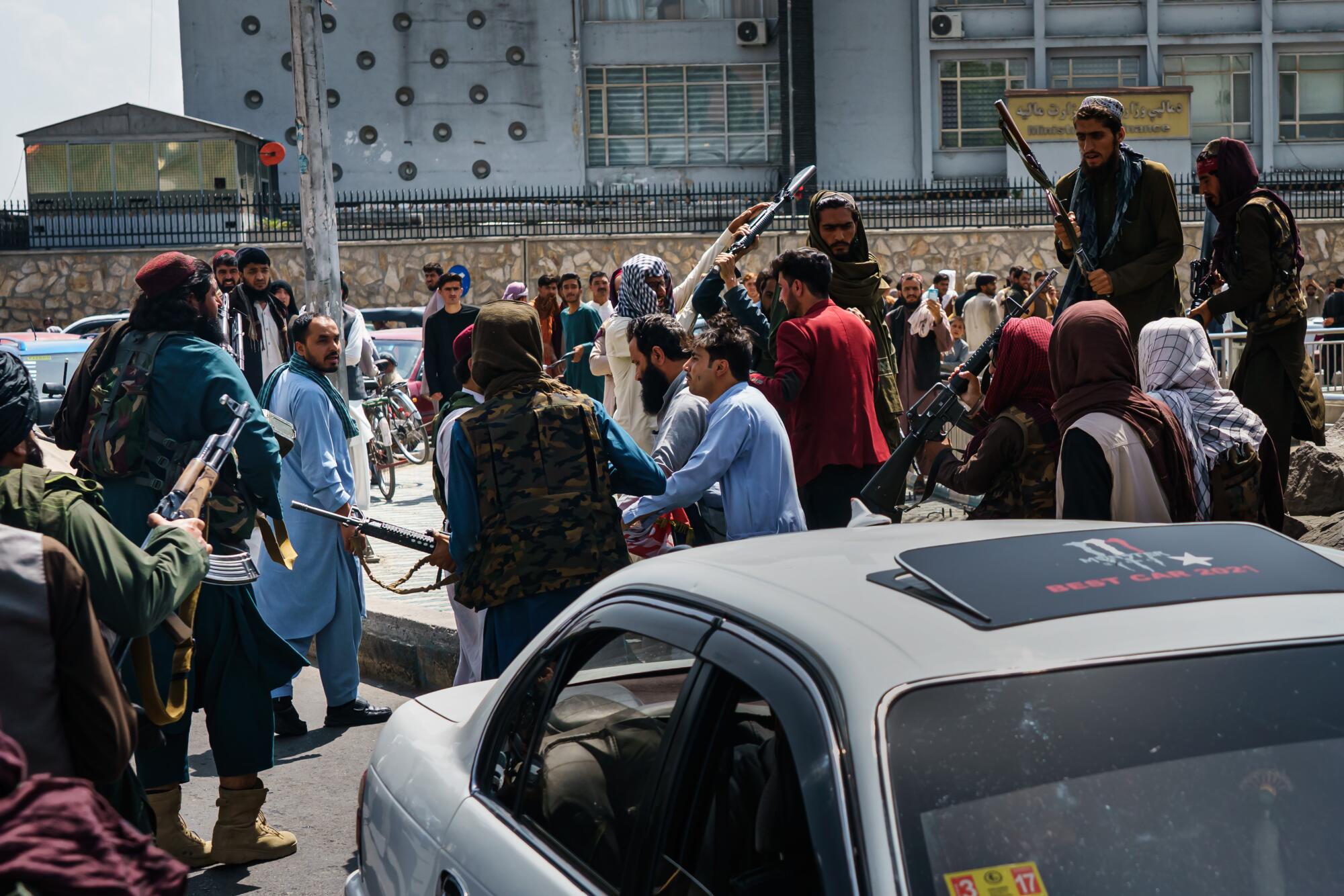
Then gunfire rang out and the crowd started to scatter. The burly fighter turned to see the commotion. I tried to slowly move away, and that’s when he turned and took a huge swing at me that knocked me down. My spectacles flew off my face.
I could see him gripping his Kalashnikov tighter, and I felt intense fear. The big man kept yelling. The best thing I could do was try to deescalate. I raised my hand and told him, “Please do not hurt us. We’re journalists, we’re foreigners.” We kept saying: “We’re media. We’re allowed to work.”
At that moment, members of the Taliban special forces — a unit called 313 Badri — showed up to clear the square of any remaining protesters. They marched right past us. With the Taliban fighter still standing over us, I had to fight every instinct in my body not to raise the camera and take a picture of the scene.
My thoughts were in a swirl. I felt disoriented; my head was throbbing. But my mind raced through options to get out of this situation without any more violence.
Then, a surprise: The radio-wielding Taliban revealed that he was able to speak and understand English. He insisted we delete the images of what had just happened. We repeated that we were journalists, that we were documenting the news.
Radio Taliban, as I’d started to think of him, had by now decided to treat us a lot better. He started asking how we were feeling, if we needed to go to a hospital. He suggested bringing us to a safer location, which sounded to me like a code word for detention. So we declined and asked politely to be allowed to return to our offices. Continuing to speak, he moved us out of the hot sun to a shady corner, asking us who we worked for.
After we named our publications, his expression changed.
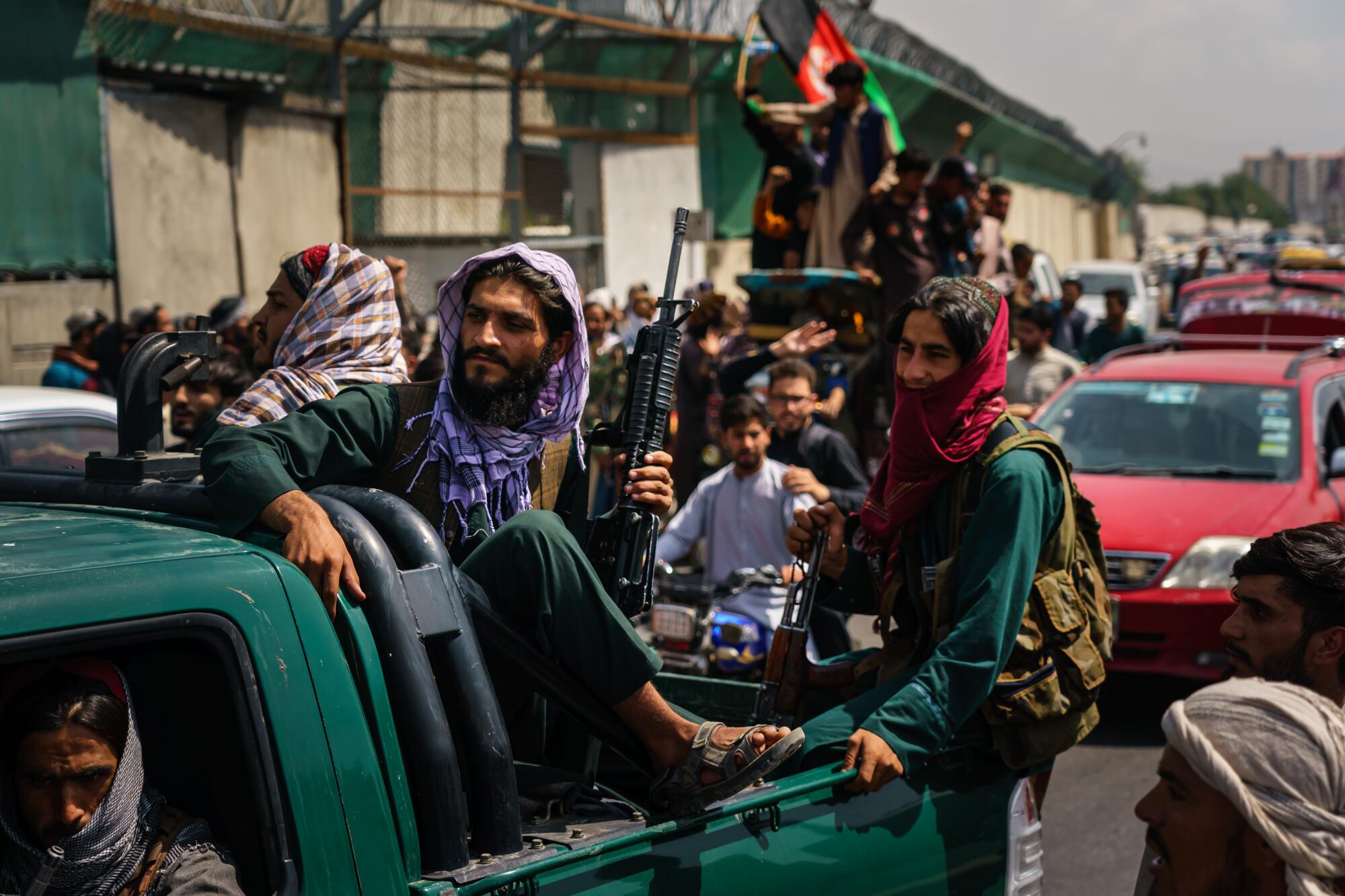
He apologized profusely for our troubles, but not for beating us. They became solicitous: We were each brought a bottle of cold water and a can of Monster Energy drink, a favorite of the U.S. soldiers who controlled the city until a few days ago.
Radio Taliban asked us: “Please, could you tell me who hit you? We will capture him, and punish him.” I looked at my colleague in disbelief.
Taliban fighters lash out at a crowd of hundreds corralled outside Kabul’s airport in a tumultuous scene from the U.S. withdrawal and Taliban takeover.
It was a surreal scene. The day before I’d been at a news conference in which the Taliban made promises about a brighter future, a free press. We kept repeating that we needed to return to the safety of our offices.
Our captor asked for a phone number for our driver. Instead, I pulled out a burner phone and called my driver on it, then passed the phone to the Taliban fighter. They coordinated, like people arranging a coffee date, and after a few minutes, we were escorted to our vehicle.
Another Taliban fighter joined us. He said his name was Hamid Nazri and that he had worked in a bank. Our assailant wouldn’t give us his name, but they all started joking with us about how we could be mistaken for locals because of our traditional dress.
We said our goodbyes. Nazri asked for a selfie. We obliged, but I didn’t smile.
We jumped in the car and raced away.
It wasn’t even noon yet, and the temperature was scorching.
I went home and iced my injuries. I hoped they wouldn’t get too black and blue.
More to Read
Sign up for Essential California
The most important California stories and recommendations in your inbox every morning.
You may occasionally receive promotional content from the Los Angeles Times.
